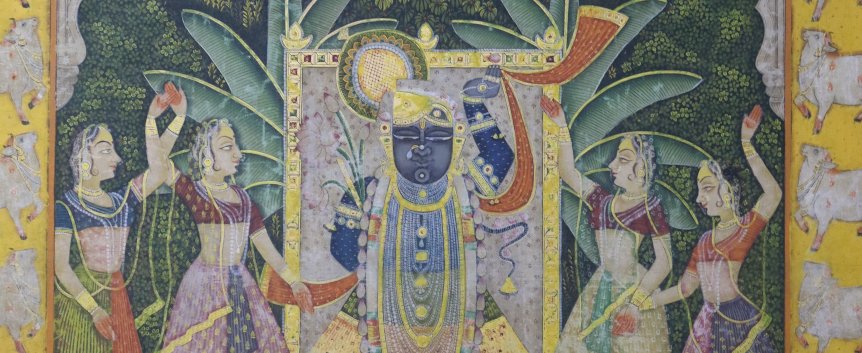The ultimate purpose of paintings, or all art, is to evoke emotions (or Ras) in the observer. Indian Pichwai paintings too are meant to generate Bhakti ras in the viewer by evoking stories often from the life of Lord Krishna. The word is derived from Sanskrit, where “pich” means behind / back and “wais” means hanging. These works of art on textile were created as backdrops to the main idols in temples. The art of pichwai painting developed in the 18th century and continues to this day. Over time it has developed into an art-form which is even used by devotees in their homes.
Pichwai or Picchwai are textiles focused on depictions of Lord Krishna and devotion to him in his various forms. They draw inspiration from the Bhagwath Purana – and often Lord Krishna is depicted in his 7-year-old child Krishna form of Shrinathji. These textiles could be in the form of paintings, embroideries or even European machine made lace work.
Classical themes in Pichwais are characteristic in their depictions. Some of these classical representations are:
1. Annakoot (Govardhan Pooja)
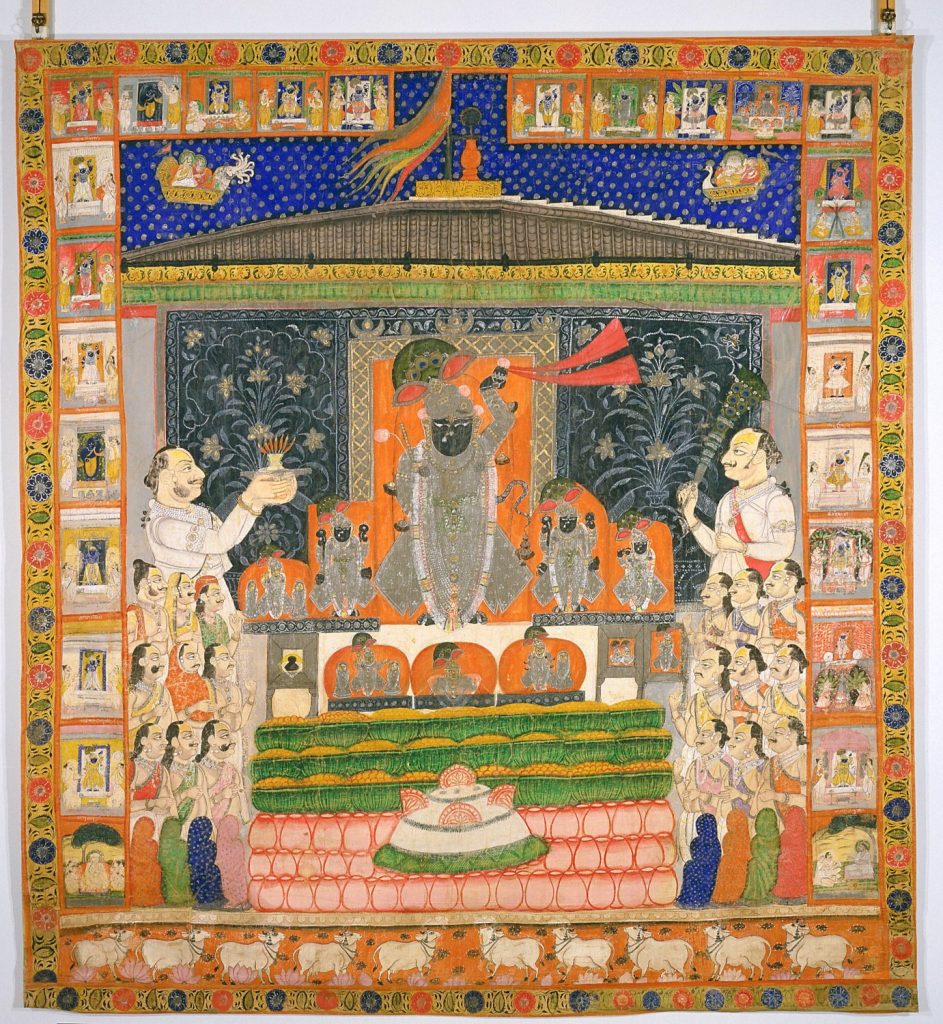
Source: Annakoot Pichwai, 19th Century, Kota, Rajasthan, India (Arthur M. Sackler Gallery)
A popular theme, Annakoot depicts Krishna is shown with his left arm raised above his head representing how Krishna raised the Govardhan mountain. Offerings are shown to be laid out in-front of the idol representing the offerings that Lord Krishna asked the villagers to offer to mount Govardhan instead of to Indra. This angered Indra, who did not realise who Krishna was, and started to punish the villagers with torrential rain and storm. It is then that Krishna raised the entire mountain with his left hand in a display of his divinity.
2. Gopashtami

Source: Gopashtami Pichwai, Late 18th Century, Deccan, India (Metropolitan Museum of Art)
This festival which takes place in late autumn, marks the coming of age of Krishna from a young cow herd to a full cowherd. These typically depict a large number of Cows adorned with hand prints, peacock plumes and bells.
3. Raas Lila
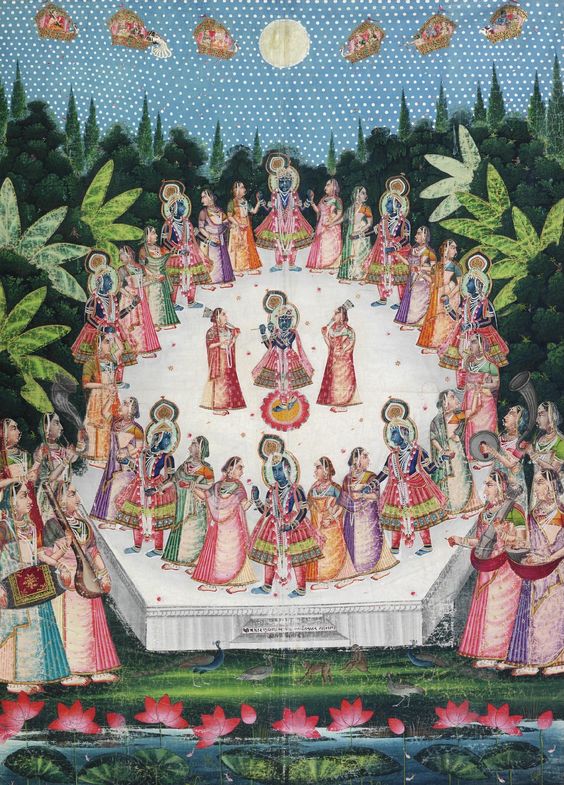
Source: Raas Leela Pichwai, Early 20th Century, Nathdwara, India (Indian & Southeast Asian Art, 2009, Sotheby’s)
On a full moon night, adolescent Krishna dances with his gopis (maidens) in the Vraj forests. Krishna is shown to have taken numerous forms so as to give his personal attention to each of the Gopis. The story can also be understood to mean that the Lord gives his personal attention to every true devotee.
4. Daan Lila
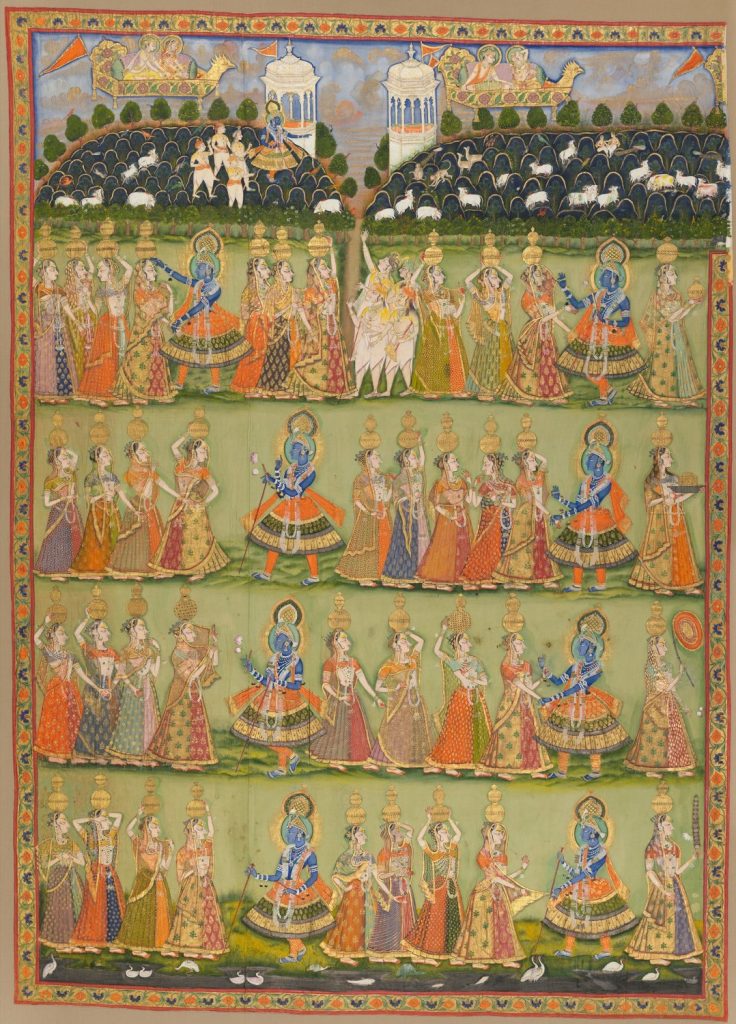
Source: Daan Lila Pichhwai, Early 20th Century, Nathdwara, Rajasthan, India (Harvard Art Museums)
As depicted, in this Lila, Lord Krishna demanded milk and butter from the gopis as a toll for safe passage home. These pichwais depict the gopis sharing their milk with Krishna or suggest the same as Shrinathji is shown being approached by gopis bearing milk pots on their heads.
5. Vrikshachari

Source: Vrikshachari Pichwai, 18th Century, Bikaner, Rajasthan, Indian (Philadelphia Museum of Art)
In this theme, Lord Krishna is symbolically represented as the kadamaba tree, Gopis are depicted on either side of the tree, in reverence of the Lord, carrying offerings of garlands, peacock fans, flowers and fly whisks almost as if in wait for the tree to turn into Lord Krishna.
Apart from these popular themes above, several other less standard depictions of Krishna are also painted as pichhwais, for example Janmashtami & Nandmahotsav depictions, Scenes of Radha-Krishna, Scenes from the Life of Krishna, Pilgrimage routs in Vrindavan etc.

Example of a story panel surrounding the main pichwai

Example of panels depicting Shrinathji in different attires
Often, the main scene is also surrounded by smaller panels depicting different stories from the life of Krishna or Shrinathji in different attire as is customary for the shrinathji idol in Nathdwara. Nature too forms a integral part of all pichwais, with diverse flora and faunna being often depicted.
Many a times the pichwais themselves do not contain Krishna himself, but in-direct references to him through his various symbols of Cows, Peacocks, Kadam trees. Sometimes they even depict repetitive elements from standard pichwais like lotuses in a pond. One has to keep in mind that pichwais are backdrops and not usually the direct subject of prayer and therefore are used as elements to create a mood in which the devotee can slip into bhakti ras.
Centers of Picchwai making
Antique Pichwais were primarily made in Rajasthan however few have also been made in Deccan and some like the machine made lace work pichwais were made in Germany (Europe). The main centres of antique pichwai painting in Rajasthan were Nathdwara, Kota & Kishangarh. In modern times, many artists have also migrated to and setup ateliers in Jaipur & Udaipur, however they still draw on traditional methods and styles developed in Nathdwara & Kotah. The characteristic styles of painting in Nathdwara, Kotah & Kishagarh can be differentiated based on the features of the faces used and colour schemes employed.
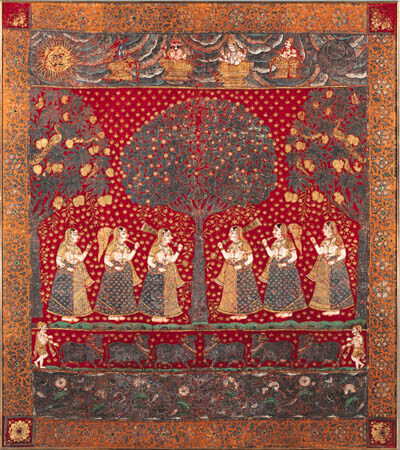
While antique Nathdwara & Kotah Picchwais can be found most easily, antique Deccan picchwais are very rare and therefore extremely expensive. These were usually made on Red or deep Indigo backgrounds with mineral colours and gold or silver foils and had their own characteristic body and facial structures different form the Rajasthan styles of painting. These are the most expensive of picchwais and have sold for very high amounts in important auctions.
The European machine made lace pichwais or net pichwais are also very collectable as these can no longer be made and are now difficult to find.
Indian Pichwai paintings have a broad appeal, and are loved by not just the knowledgeable collectors, but even the art novices and devotees. Their large formats, colourful & vibrant presentations and joyous moods can make any space come alive. Whether you are a collector of antique pichwai or are looking for fine contemporary works to liven up your interiors, do reach out to us and we may have just what you’re looking for.
Suggested reading:
- Amit Ambalala. “Krishna as Shrinathji”. Mapin Publishing, 1987
- Vivek Nanda. “Krishna & Devotion: Temple Hangings from Western India”. Asia House, 2009
Our Collection
Check out some of the pichwais in our collection (Click on images for high resolution images). If you are interested in any of the pichwai paintings, then please contact us on whatsapp – Click here

